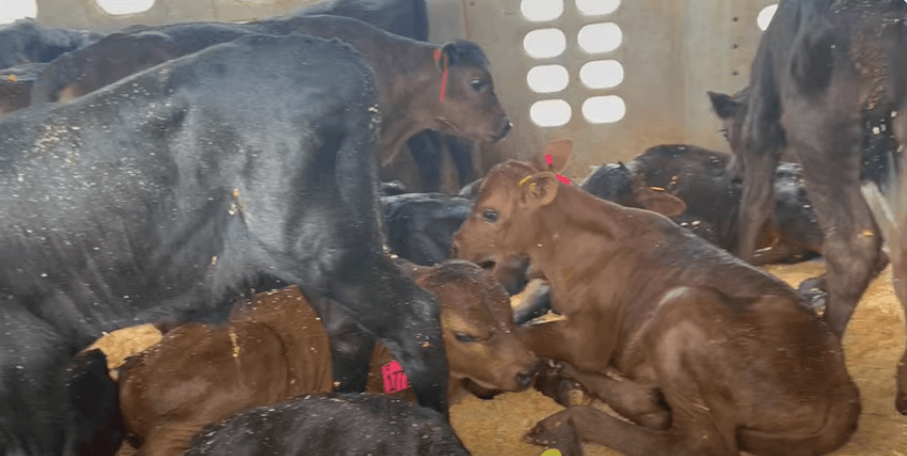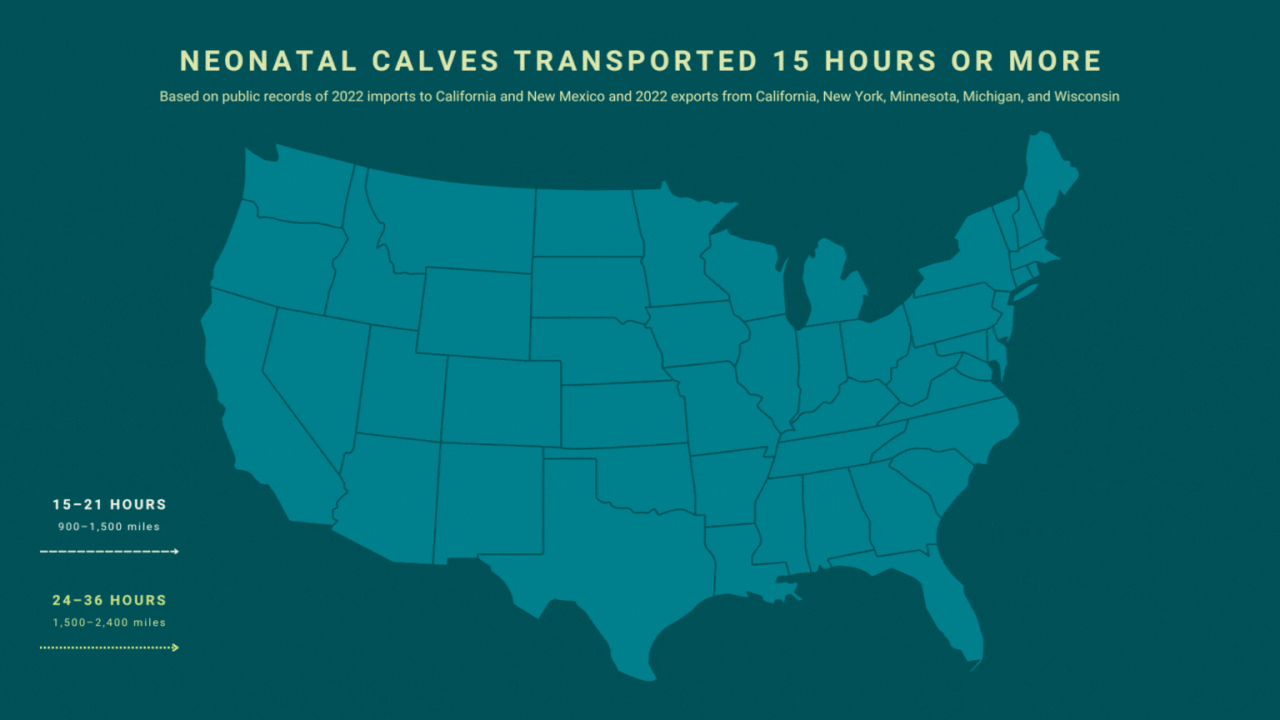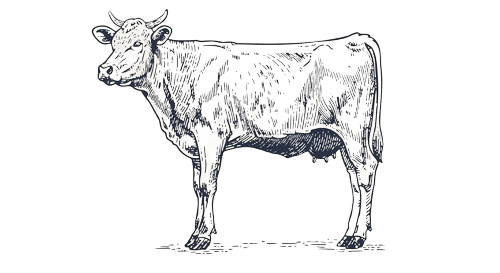The 1,000-Mile Journey of a Newborn Calf
Hundreds of thousands of newborn calves are trucked across the country every year. Here’s what you need to know about the practice.
The 1,000-Mile Journey of a Newborn Calf
Hundreds of thousands of newborn calves are trucked across the country every year. Here’s what you need to know about the practice.

Photography courtesy of Animal Welfare Institute/Animals’ Angels
Last August, members of Animals’ Angels drove behind a transport truck for 1,113 miles from Minnesota to New Mexico. Commissioned by the Animal Welfare Institute, Animals’ Angels was able to begin filming as the truck was being loaded, packed tightly with newborn calves. In filming this journey, which would cause unnecessary harm to the calves, the investigators would show a rarely documented side of the mega-dairy industry.
Two hours into the journey, the truck stopped for fuel in South Dakota. The Animals’ Angels investigators were able to approach the truck and see the ear tags for the calves. They were about one week old, and crammed together so tightly they were stepping on each other.
The truck continued to Kansas, where it stopped again for gas. At this point, temperatures had reached 100 degrees, but at no point were the calves given water or milk. The investigators could hear the calves bellowing in discomfort.
Video courtesy of Animal Welfare Institute/Animals’ Angels
There are a few issues here, says Adrienne Craig, senior policy associate and staff attorney for the Animal Welfare Institute. First is that these calves were being transported so young—sometimes just a day or two after they are born—before they had the chance to develop mature immune systems. This makes them vulnerable to disease during transport, potentially resulting in death. In this particular truck, the calves still had their umbilical cord attached, creating a risk for infection.
Second is that the conditions of the trip are stressful. The vibrations, noise, fumes, and abrupt motion of the road cause discomfort for the calves. During the 19-hour transport that Animals’ Angels investigators documented, they witnessed this truck reach risky speeds of up to 90 miles per hour, maintaining speed on curves. The investigators felt confident the calves were tossed around in the back.
Typically, calves this age will eat every few hours or so. During the entire trip, the investigators did not see the calves get fed even once.
“We know that they’re not being fed on these journeys, because the logistics of stopping and bottle-feeding 200 neonatal calves is entirely unfeasible,” says Craig.
When the truck reached its final destination, Animals’ Angels was not able to follow it inside to see the condition of the calves. But they drove by the next day to see where the calves were kept. It’s called a ranch, but it’s anything but idyllic—the investigators drove by and saw row after row of confined hutches filled with calves.

Product of consolidation
The long-haul transportation of newly born calves is a practice that has become common for very large dairies with tens of thousands of cows. According to research by the Animal Welfare Institute, hundreds of thousands of newborn calves are transported long distances every year to ranches where they are raised, either to be returned to the dairy as milking cows or slaughtered for dairy beef.
The problem is that the conditions of this travel at such a young age put these calves in a vulnerable situation, says Craig. Despite this, there are virtually no enforced legal protections for calves in this position.
“Some producers don’t prioritize…feeding them in such a way that they’re in the best shape to be transported these long distances,” says Craig. “Unfortunately, there just really isn’t any oversight on this.”
CONNECT WITH EXPERTS
“When you have too many animals in one place, you’re going to have too much waste in one place, and that waste becomes a problem—that waste becomes a pollutant,” says Chris Hunt, Deputy Director of Socially Responsible Agriculture Project (SRAP). Modern Farmer’s reporting is strengthened by the expertise of organizations like SRAP
The dairies that participate in this practice are the ones with tens of thousands of cows, commonly called mega-dairies. It’s unclear when exactly this practice began, says Craig, but it has likely increased since dairy cows and beef cattle began being bred together to produce cows raised for “dairy beef,” dairy industry cattle that are butchered for consumption.
Dairies require pregnant cows, but at mega-dairies, many of the calves do not remain there after they’re born. Many mega-dairies ship these calves to the southwest where they are raised. Some of the females will be returned as dairy cows and the rest, both male and female, are butchered as dairy beef.
Learn More
Want to eat less meat but aren’t sure where to start? Sign up for Vox’s Meat/Less newsletter course.
The industry dominance of megadairies at the expense of independent farms is a factor here. These systems prioritize efficiency, and transporting calves as quickly as possible is the most expedient option.
“It is certainly a product of consolidation of the dairy industry,” says Craig.

Solutions
Waiting until the calves are older, perhaps a month old, or at least until their navel has healed from the umbilical cord, would make transport a lot safer for them, says Craig. The AWI has filed a petition with the USDA to improve regulations for interstate transport of young animals.
Existing protections for interstate animal transport begin and end with the Twenty-Eight Hour Law, which states that animals must be offloaded for rest, food, and water if they have been traveling for 28 hours. However, this law is not consistently enforced.
In June, Representative Dina Titus of Nevada introduced the Humane Transport of Farmed Animals Act to Congress, a bill that, if it becomes a law, would require the USDA to come up with a way to enforce the Twenty-Eight Hour Law, and it would make it illegal to transport animals deemed unfit to travel. This could be because of sickness, injury, or being too young.
Take action
Let your representatives know what you think about the Human Transport of Farmed Animals Act.
Craig recommends that shoppers who are hoping to avoid supporting these kinds of practices can look for the third-party certifications Global Animal Partnership and Animal Welfare Approved on their dairy products, both of which have a minimum age requirement for transport. Another option is the Certified Humane certification, which does not have a minimum age but does have a time limit on how long animals can be on the road. You can read AWI’s full certification guide here.

Follow us
This work is licensed under a Creative Commons Attribution-NoDerivatives 4.0 International License.
Want to republish a Modern Farmer story?
We are happy for Modern Farmer stories to be shared, and encourage you to republish our articles for your audience. When doing so, we ask that you follow these guidelines:
Please credit us and our writers
For the author byline, please use “Author Name, Modern Farmer.” At the top of our stories, if on the web, please include this text and link: “This story was originally published by Modern Farmer.”
Please make sure to include a link back to either our home page or the article URL.
At the bottom of the story, please include the following text:
“Modern Farmer is a nonprofit initiative dedicated to raising awareness and catalyzing action at the intersection of food, agriculture, and society. Read more at <link>Modern Farmer</link>.”
Use our widget
We’d like to be able to track our stories, so we ask that if you republish our content, you do so using our widget (located on the left hand side of the article). The HTML code has a built-in tracker that tells us the data and domain where the story was published, as well as view counts.
Check the image requirements
It’s your responsibility to confirm you're licensed to republish images in our articles. Some images, such as those from commercial providers, don't allow their images to be republished without permission or payment. Copyright terms are generally listed in the image caption and attribution. You are welcome to omit our images or substitute with your own. Charts and interactive graphics follow the same rules.
Don’t change too much. Or, ask us first.
Articles must be republished in their entirety. It’s okay to change references to time (“today” to “yesterday”) or location (“Iowa City, IA” to “here”). But please keep everything else the same.
If you feel strongly that a more material edit needs to be made, get in touch with us at [email protected]. We’re happy to discuss it with the original author, but we must have prior approval for changes before publication.
Special cases
Extracts. You may run the first few lines or paragraphs of the article and then say: “Read the full article at Modern Farmer” with a link back to the original article.
Quotes. You may quote authors provided you include a link back to the article URL.
Translations. These require writer approval. To inquire about translation of a Modern Farmer article, contact us at [email protected]
Signed consent / copyright release forms. These are not required, provided you are following these guidelines.
Print. Articles can be republished in print under these same rules, with the exception that you do not need to include the links.
Tag us
When sharing the story on social media, please tag us using the following: - Twitter (@ModFarm) - Facebook (@ModernFarmerMedia) - Instagram (@modfarm)
Use our content respectfully
Modern Farmer is a nonprofit and as such we share our content for free and in good faith in order to reach new audiences. Respectfully,
No selling ads against our stories. It’s okay to put our stories on pages with ads.
Don’t republish our material wholesale, or automatically; you need to select stories to be republished individually.
You have no rights to sell, license, syndicate, or otherwise represent yourself as the authorized owner of our material to any third parties. This means that you cannot actively publish or submit our work for syndication to third party platforms or apps like Apple News or Google News. We understand that publishers cannot fully control when certain third parties automatically summarize or crawl content from publishers’ own sites.
Keep in touch
We want to hear from you if you love Modern Farmer content, have a collaboration idea, or anything else to share. As a nonprofit outlet, we work in service of our community and are always open to comments, feedback, and ideas. Contact us at [email protected].by Lena Beck, Modern Farmer
August 14, 2024
Modern Farmer Weekly
Solutions Hub
Innovations, ideas and inspiration. Actionable solutions for a resilient food system.
ExploreExplore other topics
Share With Us
We want to hear from Modern Farmer readers who have thoughtful commentary, actionable solutions, or helpful ideas to share.
SubmitNecessary cookies are absolutely essential for the website to function properly. This category only includes cookies that ensures basic functionalities and security features of the website. These cookies do not store any personal information.
Any cookies that may not be particularly necessary for the website to function and are used specifically to collect user personal data via analytics, ads, other embedded contents are termed as non-necessary cookies.
Instead of finding a “better” way to do the wrong thing, why not suggest eliminating animal exploitation entirely? The breastmilk of cows is not necessary for human health; in fact, it’s harmful. Besides the risks and harms that come with this type of transportation, these cows are destined for slaughter either way. The dairy industry profits off of “artificial insemination” and also slaughtering calves at young ages. Get the facts: milkhurts.org
Stop exploiting cows and stealing their babys. Cows are very sensitive beings and its cruel to treat them as Products. Dairy is also bad for your health. It promotes acne, inflammation and is linked to cancer:
https://www.ox.ac.uk/news/2022-05-06-dairy-products-linked-increased-risk-cancer
https://www.mdanderson.org/cancerwise/5-things-to-know-about-dairy-and-cancer-risk.h00-159623379.html
https://www.pcrm.org/news/news-releases/dairy-consumption-linked-prostate-ovarian-breast-cancers-finds-new-narrative